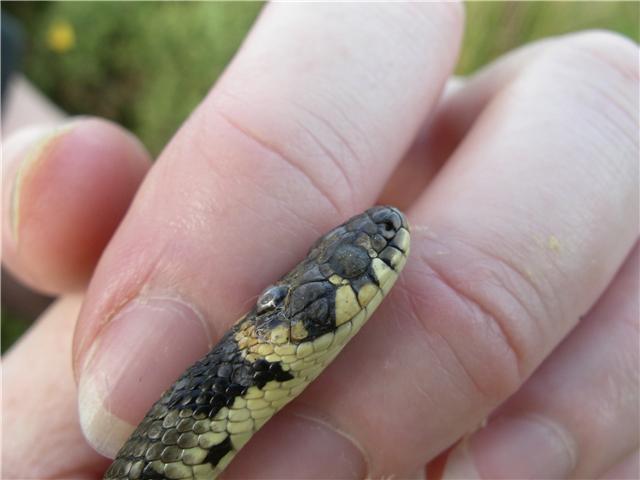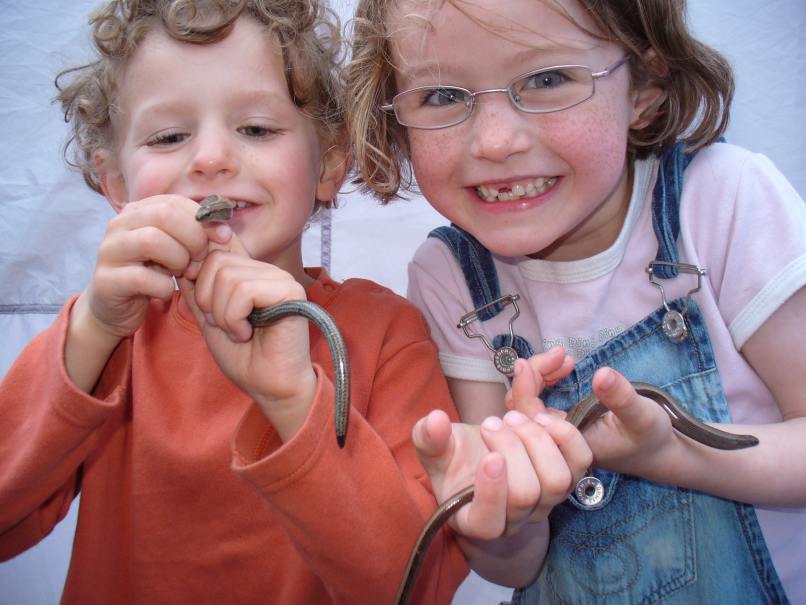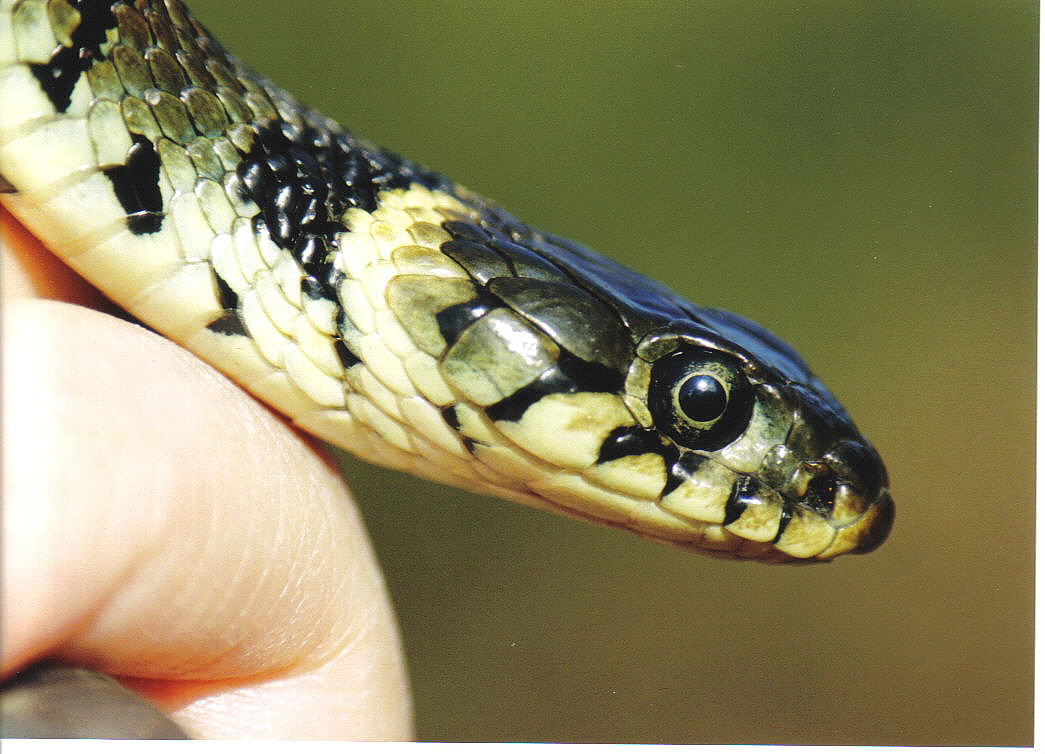 |
 |
poorly grass snake: |
| Author | Message |
|
dave fixx Senior Member Joined: 13 Mar 2007 No. of posts: 319  View other posts by dave fixx |
Posted: 25 Sep 2008 I am posting this on behalf of Mick our local reptile recorder who found this grass snake last week at a local site.Does anyone have any idea what could have happend to it or seen anything similar before? Dave  Dave Williams davewilliamsphotography.co.uk |
|
tim hamlett Senior Member Joined: 17 Dec 2006 No. of posts: 572  View other posts by tim hamlett |
Posted: 25 Sep 2008 hi dave poor thing looks absolute grimsters doesn't it try here http://www.herpvet.co.uk/ he visits the forum occasionally but hasn't been here since august. tim |
|
dave fixx Senior Member Joined: 13 Mar 2007 No. of posts: 319  View other posts by dave fixx |
Posted: 25 Sep 2008 thanks Tim will try the link. 
Dave Williams davewilliamsphotography.co.uk |
|
herpvet Member Joined: 30 Oct 2006 No. of posts: 30 View other posts by herpvet |
Posted: 26 Sep 2008 Hi, I am still here! Been a bit hectic recently. Difficult to be specific about the eye damage from the pic - I'd get it to a local vet if possible (where in Wales are you?) for a physical examination of the eye. It's important to see (if possible) if there is any damage under the spectacle as well as on the surface. The damage could have been from various things - I've seen similar lesions from subspectacular infection mainly, but also trauma (although not the sort that's likely in this case - owner tried to remove a retained eyecap with sellotape...). Flagellate subspectacular infections seem to occur not uncommonly in captive snakes, although I've never diagnosed it in a wild grass snake. Either way, some sort of treatment looks like it would be very helpful to this guy! I'm quite happy tio discuss treatment options with the local vet if they wish. Best wishes, Bruce. (Herpvet) Bruce Maclean, Bird & Exotic Animal Veterinary Services. |
|
dave fixx Senior Member Joined: 13 Mar 2007 No. of posts: 319  View other posts by dave fixx |
Posted: 26 Sep 2008 Thanks so much for the help Bruce,unfortunately so close to hibernation,Mick returned the animal to the wild,I will look out for it this weekend and see if I can catch it again. Taking hibernation into consideration would you suggest recapture and treatment or would this be just as harmfull. Thanks again Dave Dave Williams davewilliamsphotography.co.uk |
|
herpvet Member Joined: 30 Oct 2006 No. of posts: 30 View other posts by herpvet |
Posted: 27 Sep 2008 Hi Dave, Not a clear-cut decision! In theory it's not recommended to hibernate pet reptiles that are not 100% fit, as the immune system drops off drastically during hibernation, so from a purely medical view treatment would certainly be recommended. I'm not aware of any reliable figures for hibernation mortality in native reptiles off-hand (does anyone have any?), but the same considerations apply. However, it's not ideal to be treating this close to hibernation, particularly if you can't break it out of hibernation mode. Obviously it does to a certain extent depend on your views on interfering with wildlife, as well. If possible I would suggest catching it up and at least evaluating the lesion fully. It may be something that would clear up with a few days topical treatment, although often it's difficult to properly assess such lesions until the following shed. But with a damaged eye (or any other break in the surface defences) I would think the risk of infection by microorganisms during hibernation would be much increased. In theory most microorganisms are also slowed at hibernation temperatures, but not all. Hope this helps! Bruce. Bruce Maclean, Bird & Exotic Animal Veterinary Services. |
|
dave fixx Senior Member Joined: 13 Mar 2007 No. of posts: 319  View other posts by dave fixx |
Posted: 27 Sep 2008 Thanks again Bruce, The chances of me finding this guy again before hibernation will come down to tomorrow probably,I will take it as a sign if I find him and at least see if we can find out a little more. Dave Dave Williams davewilliamsphotography.co.uk |
|
Robert V Senior Member Joined: 06 Aug 2004 No. of posts: 717 View other posts by Robert V |
Posted: 03 Oct 2008
Dave, although it seems unthinkable, the "damage" to this poor blighter looks similar to a natrix I caught a few years back and which appeared to be covered in a sticky substance like tar or creosote. I hope not! Is the site near a housing estate? Rob RobV |
|
dave fixx Senior Member Joined: 13 Mar 2007 No. of posts: 319  View other posts by dave fixx |
Posted: 03 Oct 2008 hi Rob,its between 3 farms but a couple of lanes near the site had work done on them in the summer,some of it was tarmacing so its not impossible . Dave Dave Williams davewilliamsphotography.co.uk |
|
Robert V Senior Member Joined: 06 Aug 2004 No. of posts: 717 View other posts by Robert V |
Posted: 21 Oct 2008 Dave, so its quite likely then. It's a shame because underneath that gunk it looks as though it was unusual in its post ocular scales are yellow. i bet it will look a cracker when its recovered. Did I hear mention of the Herp Vet above??? Can you tell me, what would a vet need (an infected Natrix?) to be able to test to see whether the nasal infections being seen in Grassies in the last couple of years can be a mutation of myximatosis? If Avian flu can jump to humans when in close contact, then does it follow that Myxy can do the same to reptiles? Cheers Rob RobV |
|
Mark_b Senior Member Joined: 26 Jun 2008 No. of posts: 79 View other posts by Mark_b |
Posted: 21 Oct 2008 sorry for the long post I know the herpvet isnĂt around that much so thought I would do a bit of research
F FENNER 1959 ˘It was early recognized that its host range, among laboratory animals, was very restricted. Before its release in
So apart from mutated hares and in-vitro lab experiments this virus doesnĂt appear to like other species that much
Myxomatosis is from the group dsDNA viruses (a virus that has DNA as its genetic material) Family: Poxviridae (infects both vertebrate and invertebrate animals Ó an example from a different genus is smallpox in humans) Genus: Leporipoxvirus Species: Myxoma virus (which does appear to infect its host in a very specific way, so appears only capable of infecting rabbits normally)
Bird Flu is from the group: negative-sense ssRNA viruses (a virus that has RNA (ribonucleic acid) as its genetic material) - so a completely different type of virus Family: Orthomyxoviridae - influenza viruses (so all flu viruses) Genus: Influenzavirus A Only one species: Influenza A virus Its one species but it has lots of strains, including human & bird flu So thatĂs why it was so easy to have a cross over to humans, as it is still just one species that loves to mutate.
Now I am not saying its impossible that myxomatosis could mutate and infect other species, it would be stupid to state absolutes in the biological world
Anywho your questions intrigued me Robert, had to look into it, so thought I may as well share what I discovered. Now lets wait for the professional!
In terms of finding out what it is IĂm sure taking a swab of the infected area would obtain enough cells to classify it. I will ask my colleagues at the University if they may be able to test it for you if you wish 
|
|
herpvet Member Joined: 30 Oct 2006 No. of posts: 30 View other posts by herpvet |
Posted: 22 Oct 2008 Did I hear mention of the Herp Vet above??? Can you tell me, what would a vet need (an infected Natrix?) to be able to test to see whether the nasal infections being seen in Grassies in the last couple of years can be a mutation of myximatosis? If Avian flu can jump to humans when in close contact, then does it follow that Myxy can do the same to reptiles? [/QUOTE]Hi Rob, Mark's answered the basic question - like he says, never say never in biology but...few viruses will infect (as opposed to possible passive transport) different classes of animals, and with the possible exception of west nile virus I'm not aware of any that cause disease in both endotherms and ectotherms. So I would say it's extremely unlikely. Testing for viruses is unfortunately expensive and difficult to be sure a negative really is negative in reptiles. If you're seeing a disease though, it would certainly be worth getting one or more infected animals to a sympathetic vet. Investigations for various possilbe pathogens could be undertaken (bacterial, mycoplasma, Chlamydophila , fungi) as well as viral testing. The problem would be funding these tests of course. Where are you seeing these infections? Have you had any treated? What outcome? I'd be very interested to learn more. Cheers, Bruce. Bruce Maclean, Bird & Exotic Animal Veterinary Services. |
|
Robert V Senior Member Joined: 06 Aug 2004 No. of posts: 717 View other posts by Robert V |
Posted: 22 Oct 2008 Mark / Bruce, Thanks for taking the time to reply, Irealise you must both be very busy. But you have me more intrigued now with the "west nile virus"! I started seeing the Natrix virus a few years ago and realised pretty quickly (because I tripped over a live infected Rabbit in a very poor state) that it coincided with an outbreak of Myxy in the same field. The snakes use the burrows for hibernation and bolt holes in summer for cover. they must be scent tasting dead bodies, faeces, the lot. this September I came across a "fresh corpse" is the nicest way of putting it of a Natrix I know to be six years old. I will be getting the pics of that, but here are two examples (apologies to those if I've posted them before) of how it starts and develops. It appears to extend then to the mouth but obviously, I can't see if its infected the brain. How can I go about getting a grant to investigate this? Then i can get you guys to undertake the research - fascinating PHd if a break through! RobV |
|
Robert V Senior Member Joined: 06 Aug 2004 No. of posts: 717 View other posts by Robert V |
Posted: 22 Oct 2008 here they are  RobV |
|
Robert V Senior Member Joined: 06 Aug 2004 No. of posts: 717 View other posts by Robert V |
Posted: 22 Oct 2008
And how it progresses
RobV |
|
Mark_b Senior Member Joined: 26 Jun 2008 No. of posts: 79 View other posts by Mark_b |
Posted: 22 Oct 2008 I am very interested in this disease and with the facilities we have at the university I am sure we will be able to assist in researching it I am in Uni tomorrow, so I will have a chat with some of the guys This could spread around the 
|
|
Mark_b Senior Member Joined: 26 Jun 2008 No. of posts: 79 View other posts by Mark_b |
Posted: 23 Oct 2008 If you could put up all the photos you have of infected animals that would be amazing I have spoken to a Dr. that does research and has written books on reptile diseases from the University of Florida and he says ... "Possibly could be fungal but impossible to say without biopsies and histopathology" Once we get more photos up I can make more progress 
|
|
herpvet Member Joined: 30 Oct 2006 No. of posts: 30 View other posts by herpvet |
Posted: 24 Oct 2008 Hi, I'd certainly be happy to help with clinical work (treatments/taking samples) in any way that I can, if anyone can get affected animals to me (I'm based in Reading). My time and drug costs would of course be free, but lab costs might have to be covered by a grant or something. I can speak to the lab I use, but I'd need some definite cases coming before that. Just thinking that in terms of potential pathogens, more likely candidates might be ranavirus (or even chytrid I suppose though less likely) from frogs - there are ranaviruses that affect reptiles. Bruce. Bruce Maclean, Bird & Exotic Animal Veterinary Services. |
|
Mark_b Senior Member Joined: 26 Jun 2008 No. of posts: 79 View other posts by Mark_b |
Posted: 25 Oct 2008 Any idea the cost for each sample in the lab? This would assist me in choosing which grants to look at Also what samples would be needed? Finding a fresh dead grassie that appears to have died from this infection would be good, but in terms of taking samples from live individuals? Swabs or actually samples of infected flesh? Licences would be needed from the council I assume because its a wild animal, Wildlife and countryside act etc. Obviously we arenĂt going to see any grass snakes until spring now, but all these things have to be planned, grants & licences have to be applied for in advance 
|
|
herpvet Member Joined: 30 Oct 2006 No. of posts: 30 View other posts by herpvet |
Posted: 25 Oct 2008 Hi Mark, Some thoughts etc on your questions below: [QUOTE=Mark_b] >>Any idea the cost for each sample in the lab? This would assist me >>in choosing which grants to look at Depends on the lab and samples - my minimum lab costs (commercial vet lab) off the top of my head (which by agreement might be reduced by the lab) would be in the region of ˙60 for full microbiology (checking for bacteria, fungi and acid fast organisms) on pus/smears, ˙60+ for histopathology on single tissue sample (up to maybe ˙100 + if doing multiple tissues, e.g. from post mortem specimens), ˙100 + for viral testing. If really going for a full work up (adding blood profile, radiography) ˙120 + could be added to that! Obviously this would depend very much on the lab, and to a certain extent what any vet involved charged for time etc. Vets will usually (should) treat wild animals for free, but there's obviously a limit to the costs they can afford to cover. If you'd be using a local vet, see what they say. DEFRA (or whatever it's called today >>Also what samples would be needed? Finding a fresh dead grassie >>that appears to have died from this infection would be good, but in >>terms of taking samples from live individuals? Swabs or >>actually samples of infected flesh? Licences would be needed from >>the council I assume because its a wild animal, Wildlife and >>countryside act etc. For investigations a freshly dead animal allows more complete examination, which would be ideal from the research/info point of view. However, it would have to be fresh - the useful info that can be gained drops off fairly quickly with time since death (depending obviously on conditions), and much more than 24 h (48 h if refridgerated) after death the usefulness and reliability of any info is much reduced. Frozen tissues are useless for histopathology. On the other hand viral electron microscopy can be done on frozen tissue. Swabs/smears would give the basic microbiological info, probably the minimum info, but biopsies of affected tissue would be useful to clarify significance of any organisms found. Obviously the biopsies would require anaesthesia in a live animal. As far as I'm aware licences would not be an issue, since the vet would be treating the animal. No licence is needed for a vet to treat widlife, and although it is carrying out research in one sense, any tests etc are for the direct medical benefit of the animal and thus do not need to be licensed under the animal procedures act. Any comparison samples from apparently healthy grass snakes would be more of an issue though. >>Obviously we arenĂt going to see any grass snakes until spring now, >>but all these things have to be planned, grants & licences have to >>be applied for in advance Hope this helps,Bruce. Bruce Maclean, Bird & Exotic Animal Veterinary Services. |
- poorly grass snake |